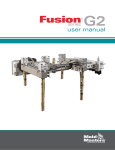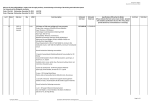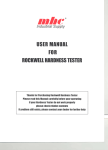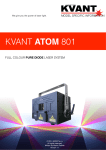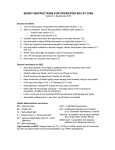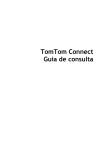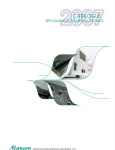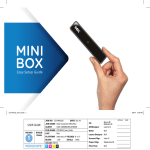Download 未命名 -1
Transcript
User Manual V1.1 User Manual V1.1 User Operating Manual Installation Address: R. Actriz Palmira Bastos, LT 102 Lisbon Telephone: +351 935866092 Email: [email protected] Skype: beonenergy web: www.beonenergy.com Operation The micro inverter offers unique technology that enables much improved solar energy harvest, increased reliability, simplified installation and efficient management of solar power systems. Catalog Each micro inverter is individually connected to one PV module in the solar panel array. This unique configuration achieves Maximum Power Point Tracking (MPPT) at the PV module level, thus eliminating single-point failure, minimizing the effect of shading, 1 Important Safety Information 02 1.1 Read It First 1.2 Safety Instructions soiling, orientations or PV module aging, and improving the system’s energy harvest by up to 50%. 04 2 Micro Inverter System 2.1 How It Work 2.2 Optimal Reliability 2.3 Easy of Design 06 3 Product Information 3.1 Overview 3.2 Major Characteristics 3.3 Datasheet 08 4 Packing Checklist 4.1 Assembly Parts 4.2 Product Description 5 Planning of Micro Inverter Installation 09 5.1 Explanations of Symbols on Inverter 5.2 Lightning and Surge Suppression 6 Micro Inverter Mounting and Wiring 10 6.1 Tool Required 6.2 Installation Diagram 6.3 Installation Steps 6.4 Cable End Installation 7 Commissioning and Operation 14 7.1 Energize the System 7.2 Micro Inverter Operation 8. Troubleshooting and Maintenance 8.1 Status LED Indications and Error Reporting 8.2 Troubleshoot an Inoperable Micro Inverter 8.3 Micro Inverter Maintenance 01 15 1 Important Safety Information markings in the technical description and on the micro inverter system and the PV equipment. Connect the micro inverter to the utility grid only after you have completed all installation procedures and after receiving prior approval from the electrical utility company. 1.1 Read It First This manual contains important instruction for use during installation and maintenance of the micro inverter. To reduce the risk of electrical shock, and to ensure the safe installation and operation of the micro inverter, the following safety symbols appear throughout this document to indicate dangerous conditions and important safety instruction. DANGER DANGER indicates a hazardous situation which, if not avoided, will result in death or serious injury. Be aware that the body of the micro inverter is the heat sink. Under normal operating conditions, the temperature is 20°C above ambient, but under extreme conditions the micro inverter can reach a temperature of 80°C (176°F). To reduce risk of burns, use caution when working with micro inverters. Do not disconnect the PV module from the micro inverter without first removing AC power. Be aware that the micro inverter has field-adjustable voltage and frequency trip points that you may need to set, depending upon local requirements. Only an authorized installer with the permission and following requirements of the local electrical utility should make adjustments. WARNING WARNING indicates a hazardous situation which, if not avoided, can result in death or serious injury or moderate injury. NOTICE NOTICE indicates a situation that can result in property damage, if not avoided. 1.2 Safety Instructions Do not use equipment in a manner not specified by the manufacturer. Doing so may cause death or injury to persons, or damage to equipment. Be aware that only qualified personnel should install or replace the micro inverters and the cable and accessories. Do not attempt to repair the micro inverter; it contains no user-serviceable parts. If it fails, contact customer service to start the replacement process. Tampering with or opening the micro inverter will void the warranty. If the AC cable on the micro inverter is damaged or broken, do not install the unit. Before installing or using the micro inverter read instructions and cautionary 02 03 2 Micro Inverter System The micro inverter system is the world,s most technologically advanced inverter system for use in utility-interactive applications. This manual details the safe installation and operation of the micro inverter. 2.1 How It work The micro inverter maximizes energy production from your photovoltaic (PV) array. Each micro inverter is individually connected to one PV mondule in your array. This unique configuration means that an individual maximum peak power point tracker (MPPT) controls each PV module. This ensures that the maximum power available from each PV module is exported to the utility grid regardless of the performance of the other PV modules in the array. That is, although individual PV modules in the array may be affected by shading, soiling, orientation, or PV module mismatch, the micro inverter ensures top performance for its associated PV module. The result is maximum energy production from your PV system. 2.3 Easy of Design PV systems using micro inverters are very simple to design and install. You will not need string calculations, and you can install individual PV modules in any combination of PV module quantity, type, age and orientation. You won’t need to install cumbersome traditional inverters. Each micro inverter quickly mounts on the PV racking, directly beneath each PV module. Low voltage DC wires connect from the PV module directly to the co-located micro inverter, eliminating the risk of personnel exposure to dangerously high DC voltage. 2.2 Optimal Reliability Micro inverter systems are inherently more reliable than traditional inverters. The distributed nature of a micro inverter system ensures that there is no single point of system failure in the PV system.Micro inverters are designed to operate at full power at ambient temperatures as hign as 65℃ (150℉). The micro inverter housing is designed for outdoor installation and complies with the IP65 environmental enclosure rating standard: IP65 rating definition: Indoor or outdoor use primarily to provide a degree of protection against hose-directed water, the entry of water during occasional temporary submersion at a limited depth, and damage from extemal ice formation. NOTE: To ensure optimal reliability and to meet warranty requirements. the micro inverter must be installed according to the instruction in this manual. 04 05 3.3 Datasheet 3 Product Information Model BeON ECO Input Data (DC) 3.1 Overview Max. input power Max. input DC voltage [ V ] Start Voltage Peak power tracking range Operating range Max. DC short circuit current Max. input current 180-300W 50V 24V 24V~50V 22V~50V 15A 10A Output Data (AC) Max. output power Nominal output current Max. output current Nominalvoltage range Nominal frequency range Power factor Total harmonic distortion (THD) Max. units per branch 250W 1.09A 1.14A 184V~265V (Adjustable with Country Deviation) 46Hz~60.2Hz (Adjustable with Country Deviation) >0.99 <3.5% 16 Efficiency 3.2 Major Characteristics Peak inverter efficiency CEC weighted efficiency 95.40% Nighttime power consumption 110mW 94.10% Mechanical Data Micro inverter has following characteristics which make micro inverter “High Efficiency, High Reliability, High Cost Effective Ratio” Wide DC input voltage and current range. Wide MPP voltage range ensure high yield under various weather conditions. High MPP tracking accuracy, ensure the minimum power loses during converting. Complete set of protection methods. Enclosure environmental rating Operating temperature range Dimensions (WxHxD) Weight IP68 -40℃~+65℃ 232mmx134mmx26mm 1.65kgs Also, following protection methods are integrated in micro inverter: Internal overvoltage Ground fault protection Grid monitoring Ground fault current monitoring DC current monitoring 06 07 4 Packing Checklist 5 Planning of Micro Inverter Installation 4.1 Assembly Parts 5.1 Explanations of Symbols on Inverter After you receive the micro inverter, please check if there is any damage on the carton, and then check the inside completeness for any visible external damage on the micro inverter or any accessories. Contact your dealer if anything is damaged or missing. Symbol Description Dangerous electrical voltage This device is directly connected to public grid, thus all work to the inverter shall only be carried out by qualified personnel. NOTICE, danger! This device directly connected with electricity generators and public grid. Danger of hot surface The components inside the inverter will release a log of heat during operation, DO NOT touch aluminum housing during operating. 4.2 Product Description An error has occurred Please go to chapter 10 “Trouble Shooting” to remedy the error. E D This device SHALL NOT be disposed of in residential waste Please go to Chapter 9 “Recycling and Disposal” for proper treatments. C A No unauthorized perforations or modifications Any unauthorized perforations or modifications are strictly forbidden, if any defect or damage (device/person) is occurred, shall not take any responsibility for it. B Description A DC connectors B AC connector C LED D Grounding hole E Wallbracket hole 08 5.2 Lightning and Surge Suppression Micro inverters have integral surge protection, greater than most traditional inverters. However, if the surge has sufficient energy, the protection built into the micro inverter can be exceeded, and the equipment can be damaged. For this reason, recommends that you protect your system with lightning and/or surge suppression devices. In addition to having some level of surge suppression, it is important to have insurance that protects against lightning and electrical surges. 09 6 Micro Inverter Mounting and Wiring 6.1 Tool Required 6.2 Installation Diagram 01. PV module 02 .Micro inverter 03 .Junction box 04. Mounting rail 6.3 Installation Steps 05 .Grounding line 06 .AC power cable Installing the micro inverter system involves several key steps. Each step listed here is detailed in the following page. Step1: Check system configuration Step2: Connect AC power cable and fix T-connector Step3: Install inverter Step4: Ground connection Step5: Install the end cap of AC power cable Step6: Connect inverter AC output and access AC power cable to AC bus box Step7: Statistics installation diagram Step8: Connect PV module 07. DC connectors 08 .AC connector 09 .T-connector of AC power cable 10 .Cable end cap 11 .T connector temporary plug cap 12 .Plug sealing cap 13. Unlocking tool DANGER WARNING DO NOT connect or disconnect the PV module and micro inverter without first removing AC power from the PV system. 10 DO NOT connect or disconnect the PV module and micro inverter without first removing AC power from the PV system. 11 Strip cable jacket 18mm~25mm WARNING Allow a minimum of 1.9cm between the roof and the bottom of the micro inverter. Also allow 1.3cm between the back of the PV module and the top of the micro inverter. Disassemble the Seal, Clamp Ring, Nut, then Insert through the cable WARNING You must install the micro inverter under the module, out of rain and sun. Do not mount the micro inverter in a position that allows long-term exposure to direct sunlight or in a vertical orientation that allows water to collect in the DC connect recess. Insert each wires into the holes NOTICE If this micro inverter is installed in Australia, Electrical Installation & Maintenance shall be conducted by licensed electrician and shall comply with Australia National Rules. Push he cable to the end. Gently try to pull out the cable. It should not be pulled out NOTICE During installation, if the arrays are mono-crystalline or polycrystalline solar cells, the array should be floating. If the arrays are thin-film cells, the PV negative pole should be grounded. Screw the sealing nut into body tightly with a force of 25 Kgf.cm 6.4 Cable End Installation Note: Wire size: 14AWG (2.08mm2) stardard / 12AWG (3.33mm2) optional Max current: 15A for 14AWG, 20A for 12AWG Recommended sealing nut torque: 25Kgf.cm (2.5N.m) Recommended installation temperature: 20℃ (60 F) upward Avoid oil and gasoline Waterproof rate: IP67 Cable color: Live: Brown / Black, Neutral: Blue / White, Grounding: Yellow / Green 12 13 7 Commissioning and Operation 8 Troubleshooting and Maintenance Please notice the symbols. Adhere to all the safety measures described throughout this manual. Qualified personnel can use the following troubleshooting steps if the PV system does not operate correctly. WARNING Qualified personnel only may connect the micro inverter to the utility grid after receiving prior approval from the electrical utility company. WARNING Do not attempt to repair the micro inverter; it contains no userserviceable parts. If the micro inverter fails, contact customer service to obtain an RMA (return merchandise authorization) number and start the replacement process. WARNING Ensure that all AC and DC wiring is correct. Ensure that none of the AC and DC wires are pinched or damaged. Ensure that all AC junction boxes are properly closed. 8.1 Status LED Indications and Error Reporting 7.1 Energize the System 1. Turn on the AC disconnect or circuit breaker for each micro inverter AC branch circuit. 2. Turn on the main utility-grid AC circuit breaker. Your system starts producing power after a five-minute wait time. Startup LED Operation: The Status LED of each micro inverter blinks green to indicate normal start-up operation approximately one minute after DC power is applied. Red blinks after DC power is first applied to the micro inverter, it is normal when the micro inverter starup. After about 5mins, the self-inspection finish. The green LED blinks 1 time per second, it indicates normal operation. 7.2 Micro Inverter Operation The micro inverter is powered on when sufficient DC voltage from the PV module is applied. The status LED of each micro inverter will blink green to indicate normal start-up operation approximately one minute after DC power is applied. You may need to use a handheld mirror to view indicator lights on the undersides of the micro inverters. 14 Post-Startup LED Indications: Use a handheld mirror to view indicator lights on the undersides of the micro inverters: Flashing Green: Indicates normal operation. Flashing Red:Indicates that the micro inverter is not operating normally. The micro inverter does not sense that the utility grid is within voltage / frequency specifications. The micro inverter cannot produce power until it is resolved. 15 8.2 Troubleshoot an Inoperable Micro Inverter To troubleshoot an inoperable micro inverter, follow the steps in the order shown. WARNING: Be aware that only qualified personnel should troubleshoot the PV array or the Micro inverter. Best Practice: Never disconnect the DC wire connectors under load. Ensure that no current is flowing in the DC wires prior to disconnecting. If necessary, use an opaque covering to cover the PV module prior to disconnecting the PV module. Always disconnect AC power before disconnecting the PV module wires from the micro inverter. The AC connector of the micro inverter is suitable as a disconnecting means. 9. Disconnect and re-connect the DC PV module connectors. The status LED of each micro inverter will blink green to indicate normal start-up operation soon after DC power is applied. The LED subsequently resumes normal operation if the Grid is present. 10. Attach an ammeter clamp to one conductor of the DC cables from the PV module to measure micro inverter current. This will be under one Amp if AC is disconnected. 11. Check the DC connections between the micro inverter and the PV module. The connection may need to be tightened or reseated. If the connection is worn or damaged, it may need replacement. 12. Verify with your utility that line frequency is within range. WARNING: The AC and DC connectors on the cabling are rated as a disconnect only when used with a micro inverter. WARNING: The micro inverters are powered by DC power from the PV modules. Make sure you disconnect the DC connections and reconnect DC power to watch for the LED blinks one minute after DC is applied. 8.3 Micro Inverter Maintenance Routine maintenance, although not mandatory, is recommended to maintain efficient operation of the PV installation. 1. Make sure AC breakers and disconnects are closed. 2. Check the connection to the utility grid and verify that the utility voltage is within allowable ranges shown in the Technical Data section on page 7 of this manual. 3. Verify that AC line voltage at all solar power circuit breakers at the load center and subpanels is within the ranges shown in the following table. 4. Verify that AC line voltage at the junction box for each AC branch circuit are within the ranges are shown in the following table: econnect DC power to watch for the LED blinks one minute after DC is applied. 230 or 240 Volt AC, Single Phase L to N 184~265V AC 208 Volt AC, Three Phase (L1 to L2) or (L2 to L3) or ( L3 to L1) WARNING It is recommended that maintenance operations be only performed by qualified personnel or personnel. The maintenance schedule may vary depending on the environmental conditions of the installation site. Routine Maintenance 184~265V AC Annual Cleaning 5. Using an disconnect tool, disconnect the AC cable for the micro inverter in question from the cable. 6. Verify that utility power is present at the micro inverter by measuring line to line and line to neutral at the cable connector. 7. Visually check that the AC branch circuit connections (cable and AC connections) are properly seated. Reseat if necessary. Check also for damage, such as rodent damage. Annual Operations Conduct an annual visual inspection (where possible) on the various components (DC cables, micro inverters and AC cables) to check for dust, dirt, moisture and water seepage. Clean the equipment if necessary. Clean using compressed air, a vacuum cleaner or special brushes, if possible. Check that there has been no drastic change in the installation conditions that might have a negative influence on radio communication with the micro inverters. 8. Make sure that any upstream AC disconnects, as well as the dedicated circuit breakers for each AC branch circuit, are functioning properly and are closed. 16 17















